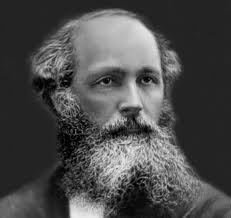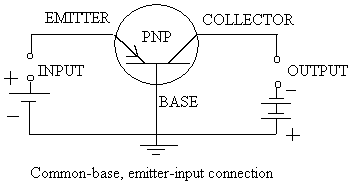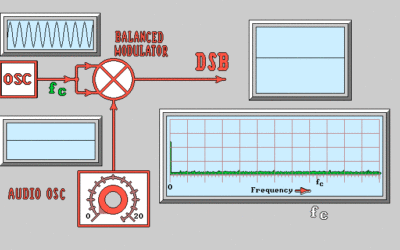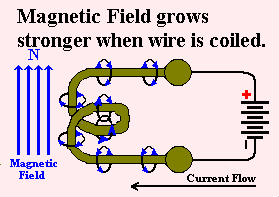 No matter which way we turn or twist the wire, the left hand rule applies. But what happens if we put a loop in the wire? When the wire is looped, as you will see from the on the right, the little magnetic fields that wrap around the wire cross through each other’s path. If you use the left hand rule, and follow around the coils of the wire, you will find that the magnetic field acts as if it is running through the hole inside of the loop. (If the loop were a donut, the magnetic field would go through the hole in the donut). Thinking along these lines… if we put a dozen donuts side to side, with a stick going through the holes, the magnetic field would follow the stick
No matter which way we turn or twist the wire, the left hand rule applies. But what happens if we put a loop in the wire? When the wire is looped, as you will see from the on the right, the little magnetic fields that wrap around the wire cross through each other’s path. If you use the left hand rule, and follow around the coils of the wire, you will find that the magnetic field acts as if it is running through the hole inside of the loop. (If the loop were a donut, the magnetic field would go through the hole in the donut). Thinking along these lines… if we put a dozen donuts side to side, with a stick going through the holes, the magnetic field would follow the stick
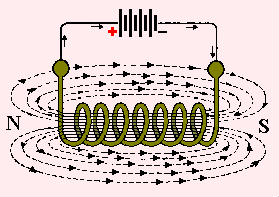 Through experimentation, it was found that if a wire is wound in the form of a coil (coiled up), the total strength of the magnetic field around the coil will be magnified. This is because the magnetic fields of each turn add up to make one large resulting magnetic field. Furthermore, it was found that the direction of the magnetic field could be predicted. The POSITIVE end of the battery is ALWAYS connected to the NORTH POLE of the coil, regardless of whether the coil is wound clockwise or counterclockwise. The coil of wire, because of their properties and capabilities, makes up one of the main components in electronics. For this reason, it has taken on many names, to include:
Through experimentation, it was found that if a wire is wound in the form of a coil (coiled up), the total strength of the magnetic field around the coil will be magnified. This is because the magnetic fields of each turn add up to make one large resulting magnetic field. Furthermore, it was found that the direction of the magnetic field could be predicted. The POSITIVE end of the battery is ALWAYS connected to the NORTH POLE of the coil, regardless of whether the coil is wound clockwise or counterclockwise. The coil of wire, because of their properties and capabilities, makes up one of the main components in electronics. For this reason, it has taken on many names, to include:
ELECTROMAGNET, INDUCTOR, SOLENOID or COIL
Coils have been given their own schematic symbol. So far we have discussed the schematic symbol for the resistor, lamp and battery. The schematic symbol for the coil is on the left. Note that there can be many variations of this, which will be discussed in more detail later.
There are several factors which determine the strength of a given electromagnet. They are:
1). The amount of current – the greater the current, the greater the field.
2). The number of turns – the greater the number of turns in a coil, the greater the field.
3). The PERMEABILITY of the core.
The core of a coil is the material that the coil is wrapped around. It can be glass, wood, metal, air, or even a vacuum. If the coil is wound upon an iron core, the strength of the electromagnet is increased several hundred times over what it would be with an air core. We say that iron is more permeable than air. Permeability is the ability of a given substance to conduct magnetic lines of force. It is similar to the effect of conductance with respect to electrical current flow. The standard for permeability is air, which is given a permeability of one. All other substances are compared to air. Some examples of substances with high permeability are permalloy and iron.
Just as conductance has an opposite – resistance; permeability also has an opposite – reluctance. RELUCTANCE is mathematically the reciprocal of PERMEABILITY. The unit of measurement for reluctance is the REL or OERSTED, and its symbol is Ö.
Voltage is the measurement for Amplitude of an electrical circuit. Magnetism also has a counterpart for this, which is called MAGNETOMOTIVE FORCE. Magnetomotive force is the force which produces the magnetic lines of force or FLUX. The unit of magnetomotive force is the GILBERT, and its symbol is G. The formula for finding the value of G is as follows: G = N x I x 1.26
Where: N = the number of turns in the coil I = the current flowing through the coil in Amperes ( N x I is also called AMPERE-TURNS)
